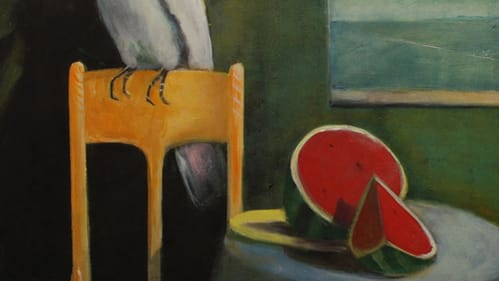Stay in the Loop
BSR publishes on a weekly schedule, with an email newsletter every Wednesday and Thursday morning. There’s no paywall, and subscribing is always free.
Beauty and affliction
Let’s be honest: Do we really seek out art when we’re in pain?

Does art matter in the hardest times? Do people seek creations like painting or sculpture when they’re suffering things like homelessness, starvation, or approaching death? This was a question I asked a room full of women while getting my hair cut and colored at my local salon. Because this group of salon-going women would likely never become homeless or go without food, I focused on the universal: would they want to see art in their dying moments? I had expected them to find the question morbid, but instead the women answered, “Yes!”
Paintings in prison
Questions like these led me to develop my prison project 10 years ago, in which I donated my art to high-security prisons. While it seemed obvious that incarcerated people might be interested in creating their own art, I wondered whether looking at another’s art—mine, in this case—would be something they would want to do behind the walls. Would art enable them to experience incarceration differently? I donated 100 paintings to various prisons, including 50 to one New England prison. Ten years later, the paintings still hang there—in chow halls and block community rooms, in the mental health unit, library, and hospice.
My question in the hair salon had a problem,though. Visual art encompasses a wide range of experiences, from Millie Brown's performances of vomiting colored soymilk upon canvas to Mark Rothko's paintings of large rectangles of color. Asking someone in pain to look at Rothko’s painting seems drastically different from asking if they want to see vomiting soymilk paintings. I suspect my original question imagined more Rothko than Brown.
Never simple
What did I want my prison donations to convey? This depended on what I want any painting to convey, no matter where it's hanging. The answer surprised me. I realized my intent had little to do with self-expression or message. Instead, I discovered, my criteria for success was beauty. This realization was also embarrassing: was my motivation not significant enough, too culturally defined, too biased?
“Beauty and affliction are the only two things that can pierce our hearts,” 20th-century mystic/activist/philosopher Simone Weil wrote.
And beauty is never simple. Consider James Brantley's striking portraits and landscapes. They evoke an intense emotional pause, hitting the viewer simultaneously with beauty emerging from the double narrative of particular and universal; the psychological and ontological. Or Rachel Bliss's intense paintings of her children, full of pathos and emotion with a stark beauty addressing the basic vulnerability of all parent-child relationships. Brantley’s and Bliss’s paintings become the aesthetic transformation of a beauty-and-affliction duality that pierces the heart, hovering without landing on either side, creating a third element that can’t be named.

What did they mean?
Who knows if the paintings I donated hold beauty in the harsh, isolated world of incarcerated people? I never ask these viewers directly; in prison, this question can beg answers like, “Your paintings? I love them. Get me out of here!” I wasn’t doing research, and didn’t need to know. The paintings just became part of the prison. It wasn’t until after teaching there that I got any sense of the paintings’ meanings in their context.
After class, Johnny was helping pack art supplies. Johnny, who’s 53 years old, has been in prison since he was 17. Looking at my paintings hanging in the library, Johnny said, “You know, I grew up here—with these guys. I know these guys. There’s guys in here who don’t care about nothing; not sports, not music, nothing. But I’ve seen them get emotional looking at this stuff. And that amazes me.”
“They’re terrible”
Other residents, on learning the paintings were mine, said things like, “Every time I turn around, I see one of your paintings!” I wasn’t sure if this was good. The staff were less reserved in their criticism. One corrections officer said to me, “Don’t you hate these paintings?” I was going to let him know I was the artist, but then I realized he already knew.
“Yes, they’re terrible,” I answered. “I can’t imagine anyone junking up a perfectly good prison with them.”
A comment I hear from my students—usually made in a nonchalant way—is their fear of dying alone in prison. So when those students who curated the project hung my series of bird paintings in the hospice unit, I was pleased. The hospice is a large room with infirmary beds, and the paintings are spaced around them. One afternoon, while waiting between locked gates, I overheard one officer joking with another. They thought it was funny when a dying man was heard speaking to the bird paintings. Despite the jokes, I was moved, but didn’t ask, “Did the birds give him comfort?”

What we need on the journey
My question about art’s existential meaningfulness remains unscientific. When research-minded friends suggested more rigorous feedback methods, helpful in getting grants, I thought, “How disrespectful.” To an artist, stories are more powerful than numbers.
A few years ago, a woman emailed me about visiting my studio. She hoped to bring her new baby. Since it was her first child and she had given birth later in life than average, she was finding it difficult to leave him. But in the two weeks leading up to the studio visit, I learned through friends that the baby suddenly and unexpectedly died.
I assumed the woman wouldn’t keep the appointment. I certainly didn’t call; my wondering even seemed superficial and insensitive. To my surprise, the mother, father, and grandmother came for the appointed visit to my studio. It was the first time they had left the house in 10 days; they needed to "look at beauty,” they said. As the family visited for two hours, the mother and grandmother each held Rosa and Artemesia—my poodles, the size of newborn babies—closely in their arms. Now, I still feel moved by their emotional pain and quest for beauty.
Weil wrote, “Beauty is the mouth of the labyrinth.” She suggests beauty does not take us away from pain. Instead, beauty leads a sublime path through pain; making pain a journey into transformation rather than devastation.
Sign up for our newsletter
All of the week's new articles, all in one place. Sign up for the free weekly BSR newsletters, and don't miss a conversation.

 Treacy Ziegler
Treacy Ziegler